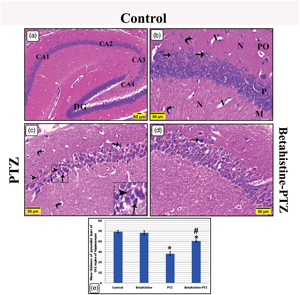Article contents
Betahistine Attenuates Seizures, Neurodegeneration, Apoptosis, and Gliosis in the Cerebral Cortex and Hippocampus in a Mouse Model of Epilepsy: A Histological, Immunohistochemical, and Biochemical Study
Published online by Cambridge University Press: 10 June 2022
Abstract

Epilepsy is a prevalent and chronic neurological disorder marked by recurring, uncontrollable seizures of the brain. Chronic or repeated seizures produce memory problems and induce damage to different brain regions. Histamine has been reported to have neuroprotective effects. Betahistine is a histamine analogue. The current research investigated the effects of convulsions on the cerebral cortex and hippocampus of adult male albino mice and assessed the possible protective effect of betahistine. Four groups of 40 adult male mice were organized: control, betahistine (10 mg/kg/day), pentylenetetrazole (PTZ) (40 mg/kg/ on alternate days), and Betahistine-PTZ group received betahistine 1 h before PTZ. PTZ induced a substantial rise in glutamate level and a considerable decrease in histamine level. Structural changes in the cerebral cortex and cornu ammonis (CA1) of the hippocampus were detected in the pattern of neuron degeneration. Some neurons were shrunken with dark nuclei, and others had faintly stained ones. Focal accumulation of neuroglial cells and ballooned nerve cells of the cerebral cortex were also detected. Cleaved caspase-3, glial fibrillary acidic protein, and ionized calcium-binding adaptor molecule 1 showed substantial increases, while synaptophysin expression was significantly reduced. Interestingly, these changes were less prominent in mice pretreated with betahistine. In conclusion, betahistine had shown neuroprotective properties against brain damage induced by convulsions.
- Type
- Biological Applications
- Information
- Copyright
- Copyright © The Author(s), 2022. Published by Cambridge University Press on behalf of the Microscopy Society of America
References
- 8
- Cited by


